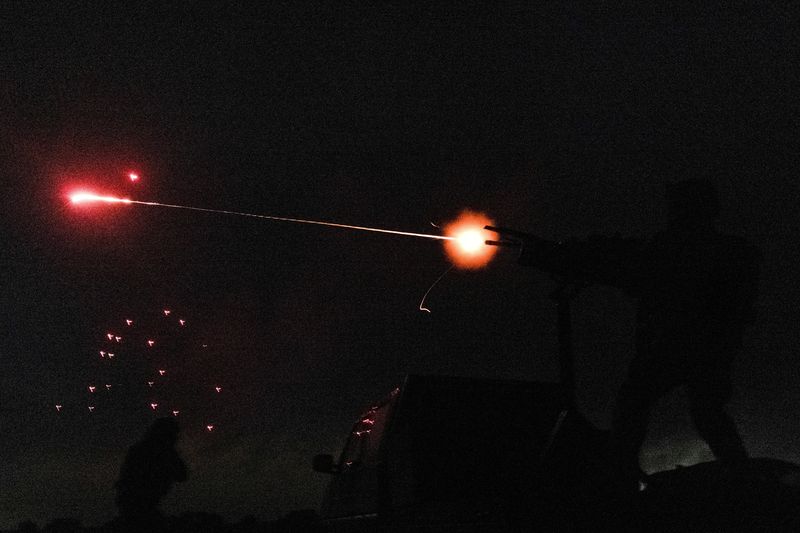Massive Drone Attack on Ukraine
On Sunday, Russia initiated its largest drone assault on Ukraine since the start of the ongoing conflict, resulting in significant destruction of homes and the tragic loss of at least one woman. This escalation in violence occurred just one day before a planned discussion between U.S. President Donald Trump and Russian President Vladimir Putin regarding a proposed ceasefire.
Ukraine’s intelligence service expressed its belief that Moscow also intended to launch an intercontinental ballistic missile later that day, aiming to intimidate Western nations. As of now, there has been no swift response from the Russian side regarding these allegations.
Diplomatic Efforts amid Crisis
In the face of this renewed aggression, President Volodymyr Zelenskiy has been actively working to mend relations with Washington after what he deemed a disappointing visit to the White House in February. On Sunday, he met with Vice President JD Vance and Secretary of State Marco Rubio in Rome during the inauguration of Pope Leo. The meeting was described as “good,” with photographs emerging of smiling Ukrainian and American officials seated together outside at a round table.
Zelenskiy emphasized Ukraine’s readiness for genuine diplomacy and underscored the necessity for a full and unconditional ceasefire to be established as soon as possible. He also met with the newly inaugurated pope, marking a significant moment in Ukraine’s ongoing search for international support.
Negotiations and Challenges
The backdrop of these events includes Ukraine’s first direct talks with Russia in over three years, which took place under pressure from Trump, who has pushed for a swift ceasefire in a war he aims to conclude quickly. During these discussions, both sides agreed to a prisoner exchange of 1,000 individuals but failed to reach an agreement on a truce, with Moscow’s proposed conditions deemed unacceptable by a member of Ukraine’s delegation.
European leaders, including those from Britain, France, Germany, and Poland, planned to communicate with Trump prior to his meeting with Putin on Monday. German Chancellor Friedrich Merz highlighted their joint visit to Kyiv the previous week, where they had urged Trump to support the introduction of new sanctions against Russia.
Potential Sanctions and Responses
When questioned about the possibility of implementing stricter sanctions on Russia, U.S. Treasury Secretary Scott Bessent stated that the decision ultimately rests with Trump. He noted, “We will see what happens when both sides get to the table,” during an interview on NBC News’ “Meet the Press” program.
Bessent reiterated Trump’s firm stance, indicating that if President Putin does not engage in good faith negotiations, the United States will not hesitate to increase sanctions in coordination with its European partners. This underscores the critical balance the U.S. is trying to maintain between diplomatic efforts and strong punitive measures against Russia.
Destruction and Civilian Impact
In a stark reminder of the conflict’s human toll, Ukraine’s air force reported that by 8 a.m. on Sunday, Russia had unleashed 273 drones against Ukrainian cities, surpassing the previous record set in February, coinciding with the third anniversary of the war.
In the Obukhiv region, located to the west of Kyiv, Natalia Piven, a 44-year-old resident, recounted a harrowing experience as her family home was reduced to ruins. Following an air raid warning, Piven and her son sought refuge in a cellar just in time to escape the first wave of drones. They quickly fled to a nearby kindergarten designated as a bomb shelter as subsequent waves of attacks targeted their village.
The destruction of their home was complete, claiming the life of a 28-year-old woman from a neighboring residence and leaving three others injured, including a four-year-old child. Piven expressed her disbelief and horror at the escalation: “I could clearly hear the drone flying right towards my house,” she told reporters, capturing the acute fear and devastation felt by civilians amidst the ongoing conflict.
Shifts in U.S. Foreign Policy
As the situation unfolds, Trump’s rhetoric surrounding U.S. support for Ukraine appears to be shifting. He has begun to incorporate elements of Russia’s narrative into his considerations about the war launched by Putin in 2022. However, Kyiv and its European allies remain determined to convey that it is Moscow that is impeding the possibility of a truce at this juncture.
Zelenskiy has indicated a willingness to accept Trump’s proposal for an immediate ceasefire lasting at least 30 days without any prior conditions. Conversely, Moscow has stated that it would entertain the idea of a ceasefire only if its conditions were met, which include halting arms supplies to Ukraine.
Additionally, Russia insists that any peace discussions must address the fundamental causes of the conflict, demanding that Ukraine cede territory, disarm, and adopt a stance of neutrality. Ukraine, however, rebuffs these terms, asserting that they would effectively equate to surrender and leave the nation vulnerable.
Conclusion
The current dynamics of this conflict demonstrate the complexity of negotiations and the tragic human consequences of warfare. As both diplomatic efforts continue amid escalating hostilities, the hopes for peace hinge on the willingness of both sides to engage constructively and prioritize a path toward stability.



